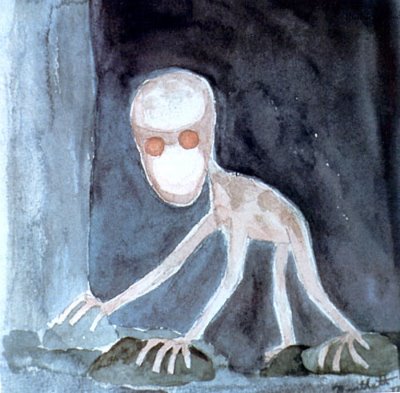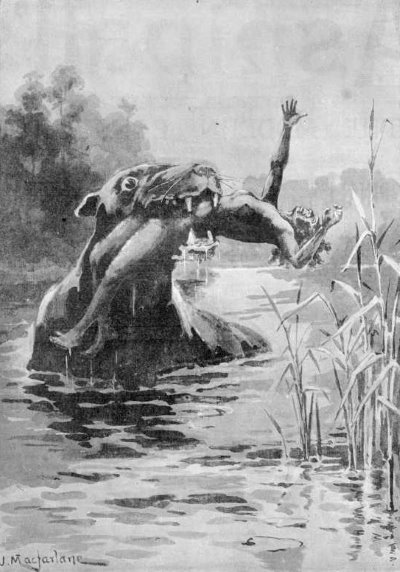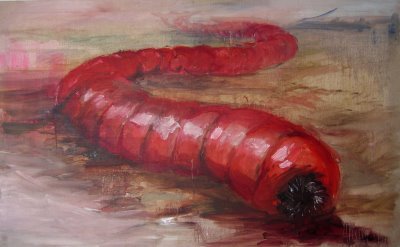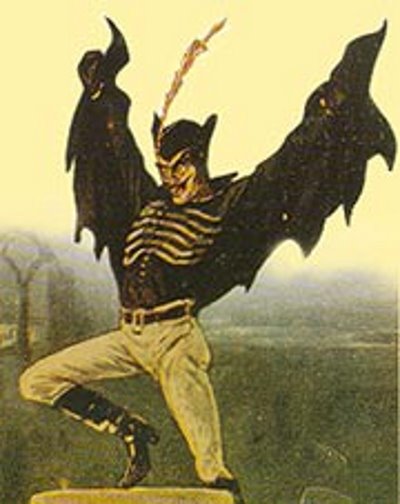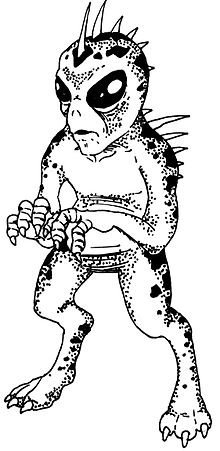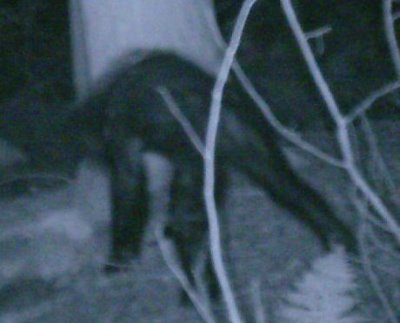From the far off snowy mountains of Tibet to the grey and gloomy lochs of Scotland, many different cultures from around the world have reported seeing strange creatures that science just can’t explain. Although evidence is typically scarce and mostly based on hearsay, many hold on to the hope that some of the following mysterious creatures really do exist.
10. The Ropen
https://www.youtube.com/watch?v=QSxq9qnFau0
Papua New Guinea, renowned for its unexplored forests and undiscovered species of both flora and fauna, is home to this mysterious monster. Stories arose from the Umboi Island of a featherless, giant flying creature with a long tail that ends in a flange and a diamond shaped head. Known to the locals as Indava, the Ropen is believed to be a nocturnal Pterosaur, very similar to a Pterodactyl, that glows against the night sky when it flies. The Ropen has become the flying hobby horse of creationists who seek to find living dinosaurs as proof that the earth is far younger than evolutionary scientists would have you believe. Five expeditions between 1994 and 2004 were conducted by said creationists, resulting in only three sightings – but even those were distant, brief views of what has been dubbed the “ropen light”. According to recent investigators over 90% of the sightings on Umboi Island are of this featureless, bright white light. Jonathan Whitcomb went on to write the book ‘Searching for Ropens’ which suggests that most sightings were of one giant creature which sleeps in the island interior during the day and at night it feeds by the reef. The locals interviewed reported that the bright glow of the Ropen lasts for anywhere up to five or six seconds. Even with all this knowledge, no real hard evidence has ever been found. The locals continue to tell stories of the glowing bird and maybe one day scientists will be seeing the same light.
9. The Bunyip
The Bunyip, or kianpraty, is a large mythical creature from Aboriginal mythology which is said to lurk in swamps, billabongs, creeks, riverbeds and waterholes. The word bunyip is usually translated by Aboriginal Australians today as “devil” or “evil spirit”. Aboriginal stories tell of a creature about 11 paces long and 4 paces in breadth. Most people who witness the monster claim to have been in such dread that they were unable to take note of its characteristics, but those that did told of a dog-like face, a crocodile like head, dark fur, a horse-like tail, flippers and walrus-like tusks or horns. Such a creature has never been recorded by European colonists but there has been multiple sightings of mysterious evidence to support such claims. The first sighting of such evidence was by Hamilton Hume and James Meehan in 1818 when they found some large bones of what looked like a hippopotamus or manatee at Lake Bathurst in New South Wales. After this, reports of more fossils came in of “some quadruped much larger than an ox or buffalo” and in 1847 a display at the Australian Museum, Sydney claimed to exhibit a Bunyip skull. Although no real sightings have been documented, the natives still tell stories of the beast screams which can be heard at night.
8. The Dover Demon
Seventeen year old William Bartlett claimed that while driving on April 21, 1977 he saw a large-eyed creature “with tendril-like fingers” and glowing eyes on top of a broken stone wall on Farm Street in Dover, Massachusetts. This was the start of the Dover Demon. Though it was only sighted by a few people in a short period of time, it is considered one of the most mysterious creatures of modern times. The second sighting came just 2 hours after the first when John Baxter swore that he saw the same creature while walking home from his girlfriend’s house. The 15-year-old boy saw it with its arms wrapped around the trunk of a tree, and his description of the thing matched Bartlett’s exactly. The final sighting was reported the next day by 15-year-old Abby Brabham who said it appeared briefly in the car’s headlights while she and her friend were driving. Again, the description was consistent with that of Bartlett. Each claimed they saw a four foot tall, hairless creature with rough-textured skin, long spindly peach-coloured limbs and large glowing orange eyes upon a large watermelon-shaped head which was nearly as big as its body. Though investigations into this unusual case turned up no hard evidence for the reality of the creature, there was also no evidence of a hoax nor a motive for perpetrating one. So was the Dover Demon just a story these kids made up, or is it still out there waiting for the right moment to strike?
7. Mongolian Death Worm
painting: Pieter Dirkx
In August 2009, two New Zealanders carrying a video camera and a sack of explosives set off to a remote southern corner of Mongolia’s Gobi desert in search of a creature that few believe exist. The Mongolian Death Worm is known locally as the Allghoi Khorkhoi, or the “intestine worm,” because it is believed to resemble the internal tract of a cow. The Kiwi duo intend to lure the monster to the surface with tremors set off by detonating their explosives. Once emerged, they planned to capture it on film. Unfortunately the men came up empty handed like many expeditions before them. The worm is subject of a number of claims by Mongolian locals and according to legend it is described as bright red with a wide body that is 2 to 5 feet (0.6 to 1.5 m) long. It lurks beneath the sand of the desert, pouncing on unsuspecting victims with such abilities as spewing acid (which on contact will corrode anything it touches) and being able to kill at a distance with electric discharge. The Mongolians also believe that touching any part of the worm will cause instant death or tremendous pain. It has been told that the worm frequently preyed on camels and laid eggs in its intestines, eventually acquiring the trait of its red-like skin. They say that the worm lives underground, hibernating most of the year except for when it becomes active in June and July. It is reported that this animal is mostly seen on the surface when it rains and the ground is wet. All in all just another reason to stay out of the desert.
6. The Spring-Heeled Jack
During the 19th Century, inhabitants of London became victim to this curious beast. In October 1837 the first sighting of The Spring-Heeled Jack was reported, appearing out of the shadows of night and attacking his victims with dreadful scratches before bounding away with superhuman ability. The first sighting was reported by Mary Stevens when she was walking to work after visiting her parents. A strange figure leapt at her from a dark alley. After immobilising her with a tight grip of his arms, he began to kiss her face while ripping her clothes and touching her flesh with his claws which were, according to her deposition, “cold and clammy as those of a corpse”. In panic, the girl screamed, making the attacker quickly flee from the scene. The commotion brought several residents who immediately launched a search for the aggressor, who could not be found. Polly Adams, a pub worker, was another of three women accosted by Spring-Heeled Jack in September of that year. He allegedly tore her blouse off and scratched at her stomach with iron-like fingernails or claws. Several witnesses claimed to have seen Jack escape the scene of the crime by jumping over a 9 ft (2.7 m) high wall while babbling with a high-pitched, ringing laughter. Through numerous accounts they were able to get a description of the monster which included a man-like hideous face, sharp iron-like claws and glowing eyes all beneath a black cloak. Spring-Heeled Jack is one of the most baffling tales to come out of Victorian England.
5. Giant Anaconda
https://www.youtube.com/watch?v=Fo0z3Dyd1J0
The vast, teeming Amazon rain forest can kill you in all sorts of ways, from encounters with ravenous piranhas to suspicious native tribes. But the most lethal terror reported to be lurking in these parts is the giant anaconda; a lightning-quick snake more than 30 ft. (9 m) long which is capable of capsizing and crushing wooden boats floating down the Amazon. Reports of giant anacondas date back as far as the European colonization of South America when sightings of snakes upwards of 50 metres (164 feet) began to circulate amongst colonists. The topic has been a subject of debate among cryptozoologists and zoologists ever since. Scientists believe that such a monstrous version of the anaconda, which in real life rarely grows beyond an already scary 17 ft. (about 5 m), no longer exists. In 2009, the discovery of Titanoboa fossils found in South America revealed that snakes in the past did in fact reach sizes of over 40ft. The Wildlife Conservation Society has, since the early 20th century, offered a large cash reward (currently $50,000) for live delivery of any snake of 9 metres (29.5 ft) or more in length, but the prize has never been claimed – despite numerous sightings of giant anacondas. Regular size snakes are enough to set anyone’s nerves on edge, but something this big is the stuff of nightmares.
4. The El Chupacabra
This impish monster – whose name means “goat sucker” in Spanish – allegedly looks like a giant rodent with palsy. A kind of half-reptile, half-kangaroo mutant. It first drew the world’s attention in 1995 when residents of the Puerto Rican town of Canovanas claimed that chupacabras were behind a spate of attacks that killed more than 150 of their livestock, each drained of its blood. Similar killings were report in Moca a few months later. Sightings have since been reported as far north as Maine and as far south as Chile. They have even been spotted outside the Americas in countries like Russia and The Philippines. The most common description of the chupacabra is that of a reptile-like creature said to have leathery or scaly greenish-grey skin and sharp spines or quills running down its back. It is said to be approximately 3 to 4 feet (1 to 1.2 m) high, and stands and hops in a fashion similar to that of a kangaroo. Some reports have even stated chupacabras were winged like gargoyles and blinked glowing-red eyes in the dark, heightening the sense of supernatural menace surrounding the creatures.
3. The Yeti
illustration: Philippe Semeria
This beast is said to be found deep in the Himalayan regions of Nepal and Tibet. The Yeti, or Abominable Snowman, was first reported in 1832 by James Prinsep, one of colonial India’s most venerable scholars. He kept an account of his trip through Nepal where he reportedly saw a tall, hairy, bipedal creature that fled upon being detected. Since then many mountaineers, including Everest conquerors Sir Edmund Hillary and Tenzing Norgay, reported footprints far larger than human feet dotting snowy trails. A 1954 expedition commissioned by the British Daily Mail retrieved dark brown hairs from a supposed yeti scalp kept in a secluded Buddhist monastery. It is believed that the Yeti was a part of the pre-Buddhist beliefs of several Himalayan people; the Lepcha people are said to have worshipped a “Glacier Being” as a God of the Hunt. A photographer and member of the Royal Geographical Society, N.A Tombazi wrote that he saw a creature at about 15,000 ft for about a minute, “Unquestionably, the figure in outline was exactly like a human being, walking upright and stopping occasionally to pull at some dwarf rhododendron bushes. It showed up dark against the snow, and as far as I could make out, wore no clothes.” Two hours later Tombazi and his companions descended and reported seeing the creature’s large footprints in the snow. One of the most renowned mysterious monsters, the yeti seems to be a docile creature with no reported attacks. One can only hope it stays this way.
2. Bigfoot
Bigfoot (also known as Sasquatch) is the name given to a cryptid ape or hominid-like creature that is said to inhabit forests in the Pacific Northwest region of North America. Indigenous folklore of the Pacific Northwest told of cannibalistic hairy men and giants who roamed the great forests and mountains of the region, abducting children in the dead of night and sabotaging the salmon-catching nets of local fishermen. In 1951, Eric Shipton photographed what he described as a Bigfoot’s footprint – named so because of its size (24 inches long and 8 inches wide). This generated considerable attention and led to the story of the creature entering popular consciousness. The craze went into overdrive in 1967 when two Californians screened a short documentary of footage that allegedly filmed the Yeti’s cousin and, in 2001, the first still picture was captured using an automatically triggered camera attached to a tree. Many tried to pass the images off as “a bear with a severe case of mange”. In 2008, two men claimed they had uncovered the body of a Sasquatch. Most of major US news networks sought images of the beast’s corpse – only to find that its head was hollow and its feet were made of rubber. Still, a cult following of researchers have dedicated their life to proving that this monster does exist.
1. The Loch Ness Monster
Reports of a large, long-necked serpent loping around the waterways of the Scottish highlands date back as far as the 7th century, but modern interest in the monster was sparked by a sighting on 22 July 1933. George Spicer and his wife claimed to have saw “a most extraordinary form of animal” cross the road in front of their car. They described the creature as having a large body about 1.2 metres high and 7.6 metres long. It also had a long narrow neck slightly thicker than an elephant’s trunk and as long as the 3-4 m width of the road. It lurched across the road towards the loch, leaving only a trail of broken undergrowth in its wake. In August 1933, a motorcyclist named Arthur Grant claimed to have nearly hit the creature on the north-eastern shore. Grant claimed that he saw a small head attached to a long neck and that the creature saw him and crossed the road back into the loch. He dismounted and followed it but only saw ripples. Sightings of the monster increased following the building of a road along the loch in early 1933, bringing both workmen and tourists to the formerly isolated area. In the past century, dozens of scientists have conducted sonar scans and plunged inside submersibles into the lake’s depths, sometimes picking up tantalizing, albeit inconclusive, readings of some mysterious, unusually sized object. However, a 2003 study commissioned by the BBC employed satellite tracking and took sonar readings from around 600 different locations in the lake and yielded nothing. Despite all this, the legend of ‘Nessie’ lives on.

